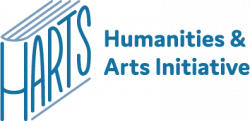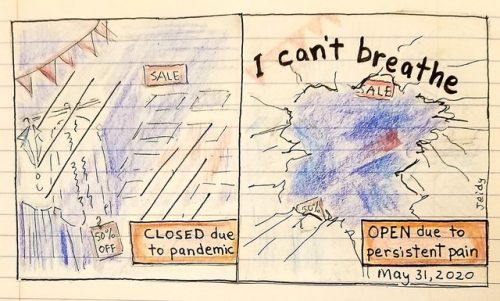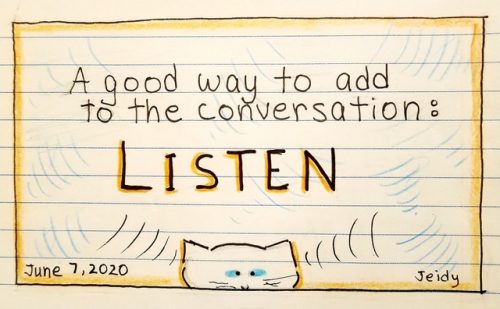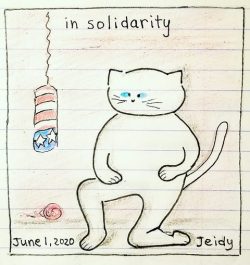This content was published: August 11, 2020. Phone numbers, email addresses, and other information may have changed.
Wellspring: Humanities and Arts During Covid-19, Summer Issue I
Posted by Andrew Cohen
“A people also perish when they fail to keep alive the values that make them human, the wellsprings of their sanity.” —Ben Okri
 We hope that you and your loved ones are well. As we settle into the summer, we wanted to share some highlights from the end of spring term that we didn’t have time to share in earlier newsletters, and to keep you apprised of wonderful humanities and arts readings and offerings from the Portland area and beyond. Please enjoy the accompanying artwork by the very talented PCC Cascade English faculty, Gail Jedy, whose “Pandemic Pictorials” were featured on the HARTS website in the late spring.
We hope that you and your loved ones are well. As we settle into the summer, we wanted to share some highlights from the end of spring term that we didn’t have time to share in earlier newsletters, and to keep you apprised of wonderful humanities and arts readings and offerings from the Portland area and beyond. Please enjoy the accompanying artwork by the very talented PCC Cascade English faculty, Gail Jedy, whose “Pandemic Pictorials” were featured on the HARTS website in the late spring.

PCC’s Humanities and Arts Highlights:
- Winners of the ASPCC Writing awards: For the past two years, ASPCC Sylvania has sponsored annual student writing awards in collaboration with the English department. We are happy to share the names of this year’s winners and runners-up:
- Winner for Creative Writing: Alex De La Cruz for “Salsa” (Short listed: Sadie Bradford, Emily Veenstra, Ethan Slayton, Hana Elogbi-Sabr)Winner for Film/Literature: Kanani Cortez for “Chubby Childhood Icons” (Shortlisted: Hailey Mathias, Damon Wise, Taylor Nichols)
- Winner for Composition: Brendon Atkinson for “The Politics of Le Guin: Politics and Religion” (Short listed: Anh Nguyen, Gracia Elena Durón Rodríguez”
- At the end of spring term, Rock Creek’s literary journal, Bellwether Review, was published. Typically a print journal, this year’s issue was published digitally due to the virus. As faculty editor and HARTS Council member, Elissa Minor Rust noted, “My students worked really hard on this during a difficult time and I am so proud of their work. I hope you check it out – there is a lot of good student writing. In addition to creative work, we were happy to publish several students whose work was accepted into the [annual Rock Creek] Groundswell Conference that was canceled; you’ll find those essays on the website.” You can enjoy the writing online.

The Humanities and Arts: Readings
- In this editorial, New York Times columnist Frank Bruni writes about the need for humanities majors to help solve the myriad problems we’re facing as a nation as well as the high risks for humanities disciplines and departments at colleges facing budget challenges. In the article he quotes Columbia University professor, Andrew Delbanco, who notes: “’This is not only a public health crisis and an economic crisis, though Lord knows it’s both of those. It’s also a values crisis. It raises all kinds of deep human questions: What are our responsibilities to other people? Does representative democracy work? How do we get to a place where something like bipartisanship could emerge again?’”
- Here’s an interesting story from NASA about a community college student, Chris Esquer-Rosas at San Bernardino Valley College, whose love of origami led to a fascinating internship at NASA’s Jet Propulsion Lab at Cal Tech. He is working on Starshade, a project that hopes to make it easier to collect data about exoplanets – the engineers are using origami principles to design the starshade. There’s an interview with Esquer-Rosas, as well as a short video that describes the Starshade project.
- In the article, “Black Musicians Talk About How to Change Classical Music,” the New York Times interviewed nine performers who “describe steps they recommend to begin changing a white-dominated field.” The conductor Roderick Cox, for one, says, “I would like changes to be made in how we train musicians in conservatories and universities. A lot of our thinking, and our perceptions of what’s good music, becomes indoctrinated at that stage. I say this because even though I’m a person of color, I was guilty of not being accepting of new voices and styles outside of Beethoven, Schumann, all the usual music of the past. When we start with preconceived notions, we limit ourselves.”
- Over the past three years, the National Humanities Alliance’s Humanities for All initiative has showcased more than 1,800 examples of publicly engaged humanities work at colleges and universities across the U.S. Recently, the Alliance has announced the launch of the Humanities for All blog, “which invites others to reflect on their own work and models and trends in the field. This new space on the Humanities for All website will feature original contributions from outside writers exploring publicly engaged humanities initiatives that address the challenges of the current moment and explore practices and trends in U.S. higher education.” In the Pandemic Journaling Project Sarah Willen of the University of Connecticut writes about a combined journaling platform and research study from an interdisciplinary team at the University of Connecticut, Brown University, and Trinity College. In Stories from the Pandemic, Tim Rafael from Rutgers University—Newark writes about web platform for young people to document their experience in real time using photography, video, writing, and audio. “Our goal was to give students an opportunity to observe, reflect, and share their personal stories in order to feel less isolated while becoming frontline documentarians for their local community and beyond.” You can read about these other projects.
- This fascinating obituary for Kenneth Lewes, a clinical psychologist who challenged the predominate psychiatric stance that homosexuality was a mental illness and recently died of Coronavirus, discusses the powerful connections between his training in literary criticism and his later work in psychology: “At the age of 36, after seven years as a professor of Renaissance literature at Rutgers University in New Jersey — and without ever having taken a psychology course — he made another transition and enrolled at the University of Michigan, where he earned a second doctorate, this time in clinical psychology, in 1982. His study of English proved surprisingly serviceable, though. ‘Literary criticism is generally better equipped to understand the depth and complexity of symbols,’ Dr. Lewes explained in the 2019 journal interview. ‘I vividly remember the first time I conducted a therapy group in a closed ward of a state mental hospital. I felt instantly at home. Here were people trying to put into words their deepest intuitions about life, much as people in the 17th century were obsessed with theological debate. The people in my therapy group, however, had not been dead for 300 years.’”
- In May, Governor Kate Brown appointed the tenth Oregon Poet Laureate, Anis Mojgani, who has been thinking “about poetry’s power to shape our imaginations as we dig ourselves out of our present nightmare.” You can read an interview with him.

Humanities and Arts: Performances and Events
- The Portland Experimental Theater Ensemble has created an interactive audio experience based on the 2015 production of All Well. “This experience was made as a way to connect with our audiences during the 2020 pandemic.”
- The Portland Art Museum, Portland Public Schools, and Create More, Fear Less are “assembling one enduring art journal, made up of many, to capture our shared story of this unique moment in history,” through the Journal On community arts project. New prompts will be posted ever Saturday this summer through mid-August.
- Finally, this week is the National Theater’s final free performance, featuring, Amadeus, starring Adam Gillen: “Vienna: the music capital of the world. Wolfgang Amadeus Mozart, a rowdy young prodigy, arrives determined to make a splash. Awestruck by his genius, court composer Antonio Salieri has the power to promote his talent or destroy it. Seized by obsessive jealousy he begins a war with Mozart, with music and, ultimately, with God.” Available for free streaming through Thursday.
